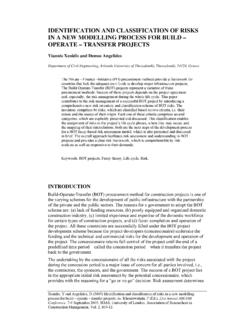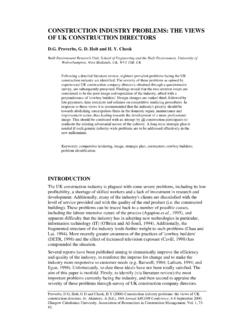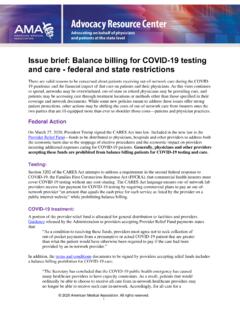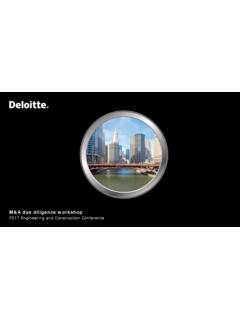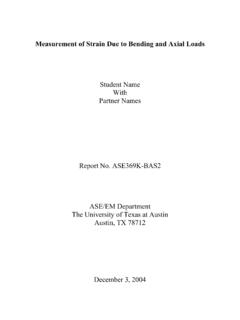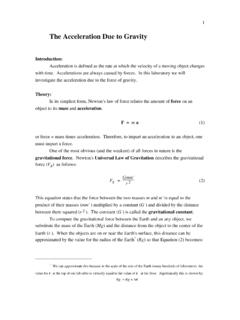Transcription of SUSTAINABLE CONSTRUCTION: CHALLENGES AND …
1 Baloi, D (2003) SUSTAINABLE construction : CHALLENGES and opportunities. In: Greenwood, D J (Ed.), 19th Annual ARCOM Conference, 3-5 September 2003, University of Brighton. Association of Researchers in construction Management, Vol. 1, 289-97. SUSTAINABLE construction : CHALLENGES AND OPPORTUNITIES Daniel Baloi1 Eduardo Mondlane University, Campus, GIU, P. O. Box 257, Maputo, Mozambique There has been an increasing concern over the impacts of construction activity on the environment and measures haven been put into practice to mitigate them. These measures include legal frameworks, cultural, technological and managerial processes. The construction industry is under severe pressure in order to adopt environmentally friendly approaches and environmental responsibility is nowadays seen as a competitive advantage.
2 However, implementing environmental management systems within construction organisations is not without significant constraints. construction sustainability has therefore been a major dilemma for the construction industry. This paper reports initial findings of a larger research project on the implementation of SUSTAINABLE construction in Mozambique. The paper presents and discusses the most important CHALLENGES and opportunities facing construction organisations in implementing environmental management systems in Mozambique. The data were collected through a case study of a construction project conducted from the client s perspective. construction organisations must devise robust and innovative environmental management strategies in order to comply with the sustainability requirements and take advantages of the opportunities arising from the implementation of such practices.
3 Keywords: construction , environment, sustainability. INTRODUCTION The construction industry plays an important role in the economic and social development of nations. The construction industry is all who plan, develop, produce, design, build, alter or maintain the built environment and includes manufacturers and suppliers of construction materials, clients, contractors, consultants and end users of facilities. The industry has however had a significant impact on the environment. The traditional approach of the industry has been based on the premise that innovations and investments drive the economic growth and satisfy the consumers needs and desires. It is however necessary to recognize that the products and processes of the industry have severe consequences on the environment.
4 construction activity makes extensive use of natural resources, various sources of energy, and water. According to Worldwatch Institute, building construction alone consumes 40 percent of the raw stone, gravel and sand used globally each year and 25 percent of virgin wood. Buildings account for 40 percent of the energy and 16 percent of water used each year around the world. The negative impacts of these activities are evident. Raw materials extraction, transportation and manufacture have often led to resource depletion and biological diversity (fauna and flora) losses (Roodman and Lensen, 1994). Energy consumption produces emissions that contribute to global warming and acid rain. Wastes resulting from the construction process often pollute air, water and can pose serious health and safety problems.
5 In addition, construction activities cause comfort disturbance and deteriorate health conditions. Baloi 290 An increasing concern over these impacts has triggered the adoption of measures to mitigate them by the different parties (Hill and Bowen, 1997). These measures include legal frameworks, technological and managerial processes. In recent years, like other industries, the construction industry has been under severe pressure in order to adopt environmentally friendly approaches and environmental responsibility is nowadays seen as an important competitive advantage. SUSTAINABLE construction SUSTAINABLE construction can be viewed as a subset of SUSTAINABLE development applied to the construction industry. It can de defined as the creation and responsible management of a healthy built environment based on resource efficient and ecological principles (Kibert, 1994).
6 Concerns over the environment deterioration date back to ancient times but the turning point towards practical and effective actions is relatively recent. The Agenda 21 was formulated in 1992 in Rio de Janeiro, Brasil, as an international blueprint for SUSTAINABLE development (development and environment). The Agenda is a comprehensive plan of action to be taken globally, nationally, regionally and locally by UN System, Governments, interest groups, businesses and the society in general. Agenda 21 provides alternatives to combat degradation of land, water, air as well as to preserve the diversity of flora and fauna. Since then all economic and social sectors including industries have made effort in order to translate and pursue sustainability within their specific contexts.
7 As a means to set a specific sustainability agenda for the construction industry, the Habitat Agenda and CIB A21 have been established. The Agenda 21 for SUSTAINABLE construction was published by the International Council for Research and Innovation in Building and construction (CIB) in 1999. According to the main principles of SUSTAINABLE construction are the following: maximisation of resource reuse; minimisation of resource consumption; use of renewable and recyclable resources; protection of the natural environment; creation of a healthy and non-toxic environment; and creation of quality in built environments. SUSTAINABLE construction embraces three main dimensions namely social, economic and environmental in contrast with the traditional perspective, where the main concerns were economy, utility, and durability.
8 The social dimension addresses issues pertaining to the enhancement of people s quality of life. The economic dimension addresses economics issues such as employment creation, competitiveness enhancement, lower operating/maintenance costs, employment creation, high quality of working environment leading to greater productivity and many others. The environmental dimension deals with the design, construction , operation/maintenance and deconstruction approaches that minimize the adverse impacts on the environment such as air emissions, waste discharges, use of water resources, land use, and others. SUSTAINABLE construction 291 DEVELOPMENT AND SUSTAINABILITY The contribution of the construction industry to sustainability is a worldwide concern. However, the problems confronting developing countries are enormous and much more complex than those affecting the developed world.
9 Typical problems of developing countries include low income, poor water supply systems, incipient sanitation systems, poor education and health systems, lack of trained human resources, finance and many others. More often than not the most basic human needs are not therefore being met, in contrast with the developed world where in many cases these needs have even been exceeded (Loh, 2000). As such, it is not surprising that much of the available resources be devoted to the solution of the most basic problems. The differences between the two worlds are significant and include skills levels, priorities, construction industry capacity and institutional capacity. Due to their huge technological advances, developed countries tend address SUSTAINABLE construction problems from the technological point of view.
10 That is the reason why the research and development agenda for SUSTAINABLE construction has a strong technological component. The ability to innovate and develop new technologies is a greater determinant of economic success than traditional factors of comparative advantage. But Welford (1996) emphasised that technological advances alone are not sufficient and science and technology can not be expected to solve all the mistakes made in the past and pave new ways to the future. Apart from the technological side, developing countries need to address the behaviour and choices of people as the main enablers for SUSTAINABLE construction as they come from a people-centred view of development ( ). This means that a change in attitudes of people towards production is urgent. The specificities of problems inherent in developing countries and the scarcity of resources to be allocated to sustainability actions have led to the need for a specific Agenda 21 for SUSTAINABLE construction in Developing Countries.






